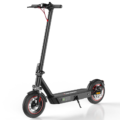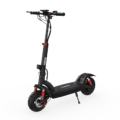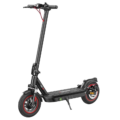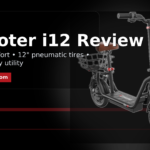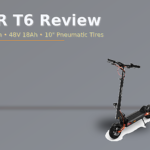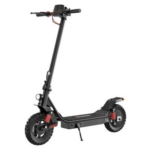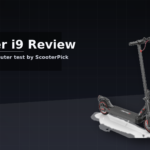- Home
- Scooters
- Electric Scooters
- iScooter i9
iScooter i9


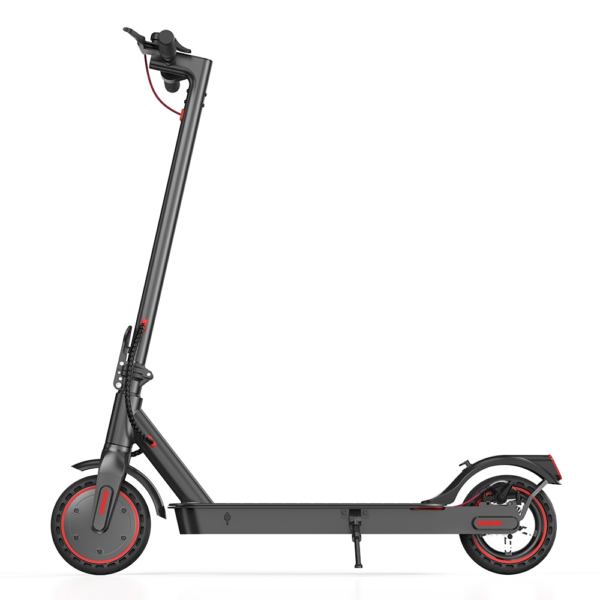
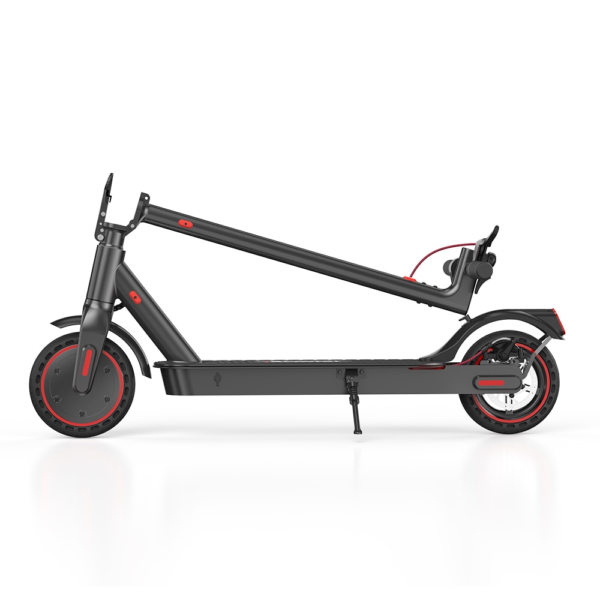
- Battery Range: 19 miles (25 km)
- Top Speed: 18 mph (30 km/h)
- Motor Power: 350 W front hub
- Weight Capacity: 220 lb (100 kg)
- Charging Time: ~3–5 h
- Scooter Weight: 27.5 lb (13.5 kg)
PROS
- Puncture-proof honeycomb tires
- Front e-brake + rear disc
- App support (MiniRobot)
- Cruise control + 2 ride modes
- Quick fold, IP54 chassis
CONS
- No suspension
- Solid tires ride firmer
- Range varies with hills/cold
- Modest hill torque

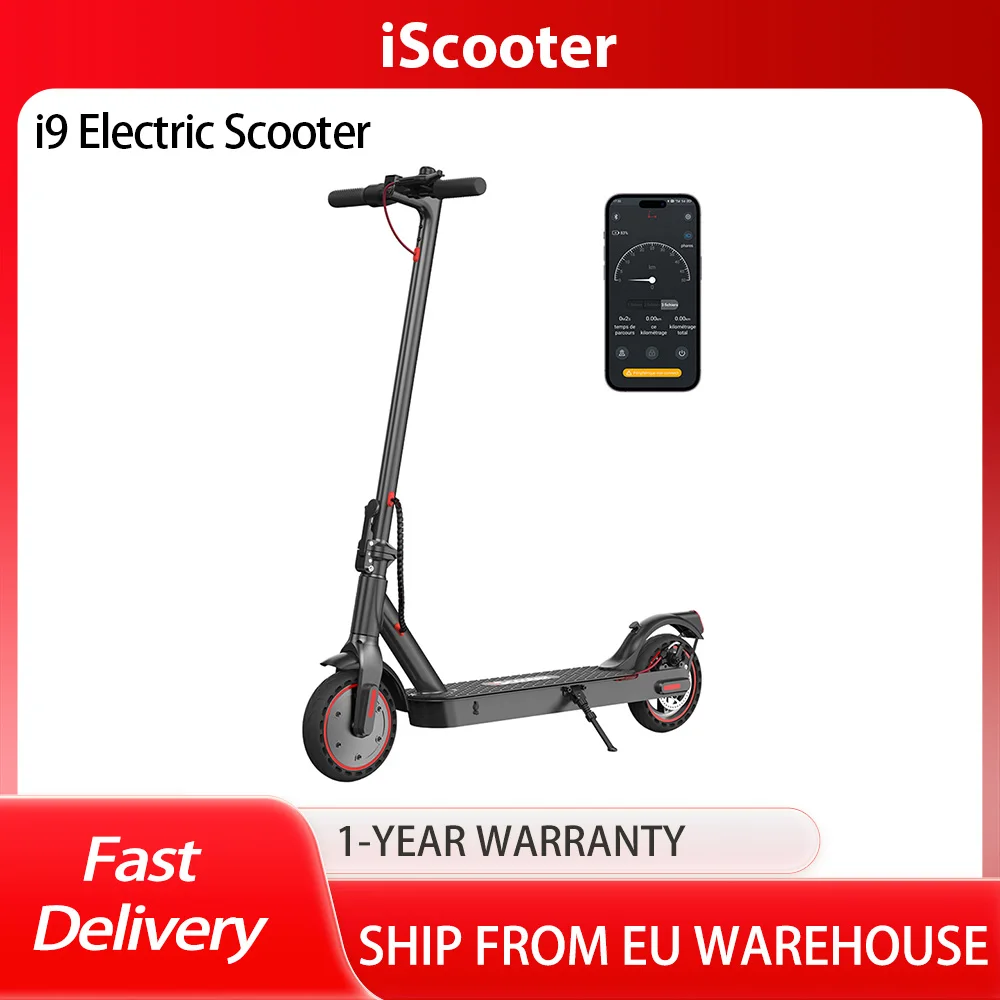

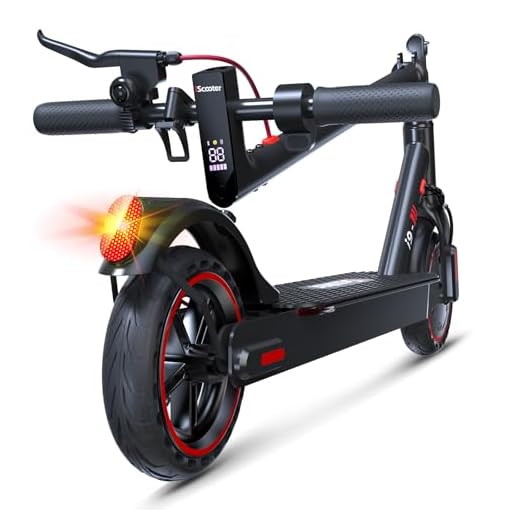
Table of contents
- What Is the iScooter i9?
- How the iScooter i9 Works
- Key Specifications
- Design & Build Quality
- Performance Fundamentals
- Battery, Range & Efficiency
- Ride Quality & Comfort
- Braking & Safety Features
- Portability & Daily Usability
- Maintenance & Care
- Weather & Seasonal Considerations
- iScooter i9 vs Alternatives
- Who the iScooter i9 Is (and Isn’t) For
- FAQs
- Glossary
- Final Notes on Real-World Use
The iScooter i9 is a light, simple, and city-friendly electric scooter built for short commutes and last-mile rides. It aims to balance weight, range, and ease of use rather than brute power. Because of that approach, it suits students, multi-modal commuters, and first-time riders who want predictable handling without high upkeep. If you are comparing it with the higher-capacity iScooter i9Max, this overview focuses on the i9’s lighter, more portable setup.
Moreover, the iScooter i9 favors practicality. It folds fast, stores neatly, and charges from a standard outlet. As a result, it works well for daily errands, short campus hops, and quick office commutes.
What Is the iScooter i9?
The iScooter i9 is a compact, entry-class e-scooter with a 36 V system, a modest hub motor, and a lightweight folding frame. Although it sits below performance models, it still covers daily transport needs for many riders. It focuses on low complexity, efficient cruising, and a durable tire setup that resists flats.
Because the chassis stays light, carrying it up a flight of stairs is manageable. Additionally, the deck provides enough space for a stable stance. The scooter’s controls remain familiar and intuitive, which lowers the learning curve for beginners.
How the iScooter i9 Works
Electric scooters share the same core parts. The iScooter i9 is no different, yet its tuning favors easy control and predictable responses.
Motor. A brushless DC hub motor sits inside the rear wheel. Think of it like a silent, sealed wheel with a built-in engine. When you press the thumb throttle, the controller feeds the motor current. Instantly, it turns electrical energy into rotation. Because there are no chains or belts, maintenance stays simple.
Controller. The controller is the scooter’s “brain.” It meters power to the motor and enforces limits for speed, current, and thermal safety. In practice, it decides how snappy the throttle feels and how smooth cruising becomes. It also coordinates electronic braking.
Battery. A 36 V lithium-ion pack stores energy. Capacity is typically around 7.5 Ah, which equals about 270 Wh (36 V × 7.5 Ah). Picture it as a compact fuel tank that prefers moderate speeds. Ride gently, and it stretches range. Ride hard into hills or headwinds, and it drains faster.
Throttle. A thumb throttle sends a signal to the controller. The first part of the press ramps power gently for stability. Moreover, it often includes cruise control logic that holds a steady pace after several seconds at constant speed.
Brakes. You usually get a dual system: electronic regenerative braking at the motor plus a rear mechanical disc. The regen system makes the motor work in reverse as a generator. Therefore, it slows the scooter while feeding a trickle of energy back to the battery. Meanwhile, the rear disc provides consistent mechanical stopping power that you can feel at the lever.
Key Specifications
Values below reflect manufacturer-rated figures for the common iScooter i9 configuration. Real-world performance varies with rider weight, temperature, terrain, wind, tire pressure, and maintenance.
| Block | Item | Value |
|---|---|---|
| General | Model | iScooter i9 |
| Intended Use | Urban commuting, last-mile riding | |
| Frame Material | Aluminum alloy | |
| IP Rating | IP54 (splash-resistant; avoid submersion) | |
| Performance & Power | Motor | 350 W rear hub (brushless DC) |
| Peak Output | ~700 W (short bursts) | |
| Top Speed (rated) | 15.5 mph (25 km/h), region-dependent limits may apply | |
| Claimed Gradeability | Up to ~10% short climbs with a moderate rider | |
| Battery, Charging & Electrical | Battery | 36 V, ~7.5 Ah lithium-ion (~270 Wh) |
| Charger | 42 V CC/CV, ~1.5–2.0 A | |
| Charge Time | ~4–5 hours from low | |
| Regenerative Braking | Yes, electronic (E-ABS style) | |
| Build & Dimensions | Tires | 8.5 in honeycomb solid (no tubes) |
| Suspension | None (rigid fork and rear) | |
| Wheelbase | Short, city-oriented stability | |
| Deck Size (usable) | ~17–18 in (43–46 cm) length × ~6 in (15 cm) width | |
| Unfolded Dimensions | ~43.3 × 16.5 × 45.3 in (110 × 42 × 115 cm) | |
| Folded Dimensions | ~43.3 × 16.5 × 19.0 in (110 × 42 × 48 cm) | |
| Weight | ~27–28 lb (12.2–12.7 kg) | |
| Max Rider Load | Up to 264 lb (120 kg), even so performance drops at higher loads | |
| Safety & Control | Brakes | Rear mechanical disc + electronic regen |
| Lights | Front LED headlight + rear brake light | |
| Reflectors | Side and rear reflectors (varies by region) | |
| Bell | Handlebar bell (varies by region) | |
| Features & Extras | Ride Modes | Multiple speed modes (Eco/Drive/Sport) |
| Display | Handlebar LED for speed/battery/mode | |
| Cruise Control | Yes, typically enabled after a steady throttle hold | |
| App/Bluetooth | Often supported for mode/lock settings (varies by batch) | |
| Warranty & Compliance | Warranty | Limited warranty; often ~12 months on main components, shorter on battery (region-dependent) |
| Compliance | CE/RoHS and local market regulations (varies by region) |
Design & Build Quality
The iScooter i9 uses an aluminum alloy frame with a simple, proven folding hinge at the base of the stem. Because the geometry is compact, the scooter feels tidy when parked and comfortable to carry. Fit-and-finish are clean for its class, and panel gaps usually sit tight enough to prevent rattles once you snug fasteners properly.
Frame and deck. The deck runs medium-long for a small scooter. Consequently, you can place one foot forward and one foot sideways without overhanging too much. The deck rubber helps with traction in light rain, although you should still ride conservatively on wet surfaces. The under-deck battery case is slim, which preserves ground clearance, yet it protects the pack with a metal shell.
Stem and cockpit. The stem has modest diameter and a simple lever-style clamp. Because there’s no external steering damper, the tuning aims for predictability rather than razor-sharp response. The cockpit keeps only the essentials: a small center display, a right-hand thumb throttle, a left brake lever, and a bell. The grips feel basic yet secure. Moreover, cable routing is mostly internal, which reduces snag points.
Fasteners and tolerances. Budget scooters depend on proper torque to stay silent. Therefore, check the hinge bolts and the brake caliper mount after your first 50–100 miles (80–160 km). If you keep them snug, the iScooter i9 remains solid. Because the tires are honeycomb solid, you avoid tube pinches and daily pressure checks, which keeps the scooter fuss-free.
Performance Fundamentals
The iScooter i9 is tuned for smooth takeoffs, calm cruising, and predictable behavior at neighborhood speeds. It does not try to launch aggressively. Instead, it ramps power in a controlled way. As a result, new riders gain confidence fast, and experienced riders appreciate the measured throttle when weaving through pedestrians.
Acceleration feel. In Sport mode, the first push is gentle, then it builds. On flat ground, you reach 10–12 mph (16–19 km/h) quickly enough to keep pace with bike paths. Moreover, the controller avoids surging, so it rarely surprises you mid-corner.
Hill-climb behavior. On 7–10% grades, expect speed to fall, especially with a heavier rider. If you keep momentum before the rise, the iScooter i9 crests short hills with a steady hum. However, long sustained climbs will slow the scooter into the mid-single digits. Because that is normal for this class, plan routes that stair-step along gentler streets.
Stability at speed. The compact wheelbase and rigid fork give the iScooter i9 a nimble feel. Above about 15 mph (25 km/h), it remains composed if your stance is athletic and your weight stays over the deck. However, you should avoid loose surfaces and metal plates, as solid tires transmit sharp bumps more directly.
Battery, Range & Efficiency
Real-world range depends on many variables. Temperature, grade, wind, tire type, tire wear, rider mass, stop-and-go frequency, and average speed all matter. The iScooter i9 uses a ~270 Wh pack, which favors trips under 8–12 miles (13–19 km) for a medium-weight rider on mixed terrain.
Rated vs real-world. The manufacturer’s “up to” claim often quotes around 18–19 miles (30 km) at low speeds on flat paths with a light rider and warm temperatures. In day-to-day use, a 165 lb (75 kg) rider cruising 10–13 mph (16–21 km/h) on mostly flat routes might see 9–12 miles (14–19 km). Heavier riders, colder weather, headwinds, hills, or high speeds cut that figure, sometimes by half.
Efficiency habits that help.
- Ride in Eco or Drive mode when traffic allows. Lower torque reduces battery sag and heat.
- Keep speed steady. Frequent sprints waste energy; cruise control helps.
- Manage weight. A backpack beats installing racks or baskets.
- Check tires. Honeycomb solids avoid flats, yet they still lose efficiency if chunked or cracked.
- Stay warm. Lithium-ion chemistry prefers mild temperatures. Range drops in the cold, so plan conservatively in winter.
Charging best practices.
- Let the pack cool to room temperature before charging after a hard ride.
- Disconnect after full. The charger will taper and hold, but it is kinder to unplug once it reaches 100%.
- Store at ~40–60% if you will not ride for weeks.
- Use the supplied charger. Third-party bricks that overvolt can damage the BMS.
- Keep ports dry. Moisture and charging do not mix.
Ride Quality & Comfort
Because the iScooter i9 runs solid honeycomb 8.5-inch tires and no suspension, ride feel is firm. That trade-off eliminates punctures and lowers upkeep. However, it also passes more vibration into the deck and bars. Therefore, road choice matters. Smooth asphalt and good bike paths feel fine. Cracked pavement and brick lanes feel chattery.
Tires. The honeycomb pattern offers a narrow “give,” which softens small imperfections. It cannot match pneumatic cushioning, yet it avoids pinch flats and daily pressure checks. Moreover, it keeps handling consistent across seasons, which is handy for commuters who just want to ride and go.
Ergonomics. The bar height suits average adults. If you are very tall, consider a slightly wider stance and a gentle bend at the elbows. The deck grip keeps your shoes planted in the rain. Meanwhile, the thumb throttle stays comfortable on longer rides because you press down rather than twist.
Handling notes. On wet paint, metal covers, and smooth tiles, reduce speed. The firm tire compound can slide if you trail brake into slick corners. Because there is no suspension, unweight the front wheel slightly over sharp edges. A soft knee bend helps the scooter float over cracks.
Braking & Safety Features
The iScooter i9 blends electronic and mechanical braking. The electronic component engages first as you roll off throttle or lightly press the lever, which harvests a bit of energy while slowing the rear wheel. Then, the rear disc brake adds stronger deceleration.
Brake feel. Bite comes on gently, then firms after about half-lever pull. Modulation is friendly, so you can feather speed on bike paths without pitch. For emergency stops, straighten the bars and shift hips back while squeezing the lever firmly. Because the tires are solid, they will chirp before locking fully, which warns you before a skid.
Lights and reflectors. A forward LED brightens the lane ahead at neighborhood speeds. It aims low to avoid dazzling oncoming riders. The rear light pulses on braking. Side reflectors increase cross-traffic visibility. Even so, a helmet-mounted light helps drivers see you over parked cars.
Ingress protection. The typical IP54 rating handles light rain and road spray. However, deep puddles and pressure washers are not safe. Water can wick along cables or past seals. If you get caught in a shower, dry the scooter and let it sit before charging.
Portability & Daily Usability
Portability is a core strength of the iScooter i9. At about 27–28 lb (12.2–12.7 kg), it is liftable with one hand. The center of mass sits near the deck midpoint, so it balances well when carried by the stem. Moreover, the folding clasp locks the stem to the rear fender hook, which turns the scooter into a compact package for stairs and train platforms.
Folding and storage. The lever-and-safety-catch system takes seconds. Verify the hinge clicks fully before riding; a partial latch invites wobble. At home, store the scooter indoors to protect electronics from temperature swings. A mat under the deck keeps floors clean after wet rides.
Carrying and transit. On buses and subways, stand with the folded scooter upright between your legs. Because the deck is slim, it occupies little space. In ride-share cars, it fits across the rear floor with the front wheel angled.
Security habits. While stopped at a café, keep the scooter in sight. If you must lock it, pass a U-lock or heavy chain through the frame triangle near the folding joint, not only through a wheel. Remove any snap-on accessories. Because lightweight scooters are easy to lift, avoid long unsupervised street parking when possible.
Maintenance & Care
You can keep the iScooter i9 running well with short, regular checks. Many tasks require only basic tools and a few minutes.
Quick schedule
- Before each ride: Squeeze the brake lever, check for smooth action, and ensure the bell and lights work.
- Weekly (or every ~30 miles / 50 km): Inspect hinge bolts, stem latch, and caliper mount. Snug to spec as needed. Wipe dust and grit from the deck and wheels.
- Monthly: Check brake pad wear and rotor alignment. Spin the rear wheel and look for rubbing or scraping. Examine tires for cracks or missing honeycomb segments.
- Quarterly: Inspect cable sheaths for kinks. Clean electrical contacts on the charger and charge port. Verify that the rear fender mount is tight.
- Seasonally: Update app firmware if supported. Test cruise control and ride modes. Open the deck only if you know what you are doing; otherwise, leave battery and controller work to a qualified technician.
Brake care. If the lever feels spongy, check the cable tension at the caliper. Adjust the barrel adjuster for minor tweaks. Replace pads when the friction material gets thin. Because the rotor is small, keep it clean to preserve stopping bite.
Honeycomb tire notes. Solids do not puncture, yet they can wear or chunk over time. Replace if you see deep cuts or missing sections. Because tire swaps on hub-motor wheels can be tricky, many riders prefer professional service.
Weather & Seasonal Considerations
Weather changes ride feel and range. Plan accordingly, and the iScooter i9 will serve you all year.
Rain. Wet roads increase stopping distances. Therefore, reduce speed and brake early. Paint lines and manhole covers become slick. Straighten the scooter before braking hard, and avoid leaning deep in corners. After a wet ride, dry the deck, rotor, and charge port. Then, wait before charging.
Cold. Lithium-ion cells lose capacity in the cold. A near-freezing morning can cut range by 20–40%. As a result, shorten your route or bring a charger to the office. Store the scooter indoors overnight to keep the pack warmer.
Heat. High heat stresses batteries and controllers. If the deck feels hot after a climb, rest the scooter in shade. Do not block ventilation grills. Moreover, avoid leaving the scooter in a parked car during summer.
Wind. A strong headwind acts like a constant climb. Expect range to drop and speed to dip. Conversely, a tailwind can help efficiency. Choose routes that duck behind buildings or trees on gusty days.
iScooter i9 vs Alternatives
Commuter scooters fall into broad groups. The iScooter i9 sits in the entry-commuter class. It prioritizes low weight, portability, and simple upkeep. Here is how that compares with adjacent categories:
Compared with budget cruisers (similar weight, similar power).
- Where the i9 excels: Quick folding, low upkeep from solid tires, friendly throttle mapping, and reliable short-range commuting.
- Where others may win: Pneumatic-tire comfort and slightly better bump absorption, at the cost of puncture risk and pressure checks.
Compared with mid-tier commuters (heavier, more battery and torque).
- Where the i9 excels: Easier to carry, cheaper consumables, and calmer power that suits tight paths.
- Where mid-tier wins: Stronger hill performance, larger decks, and longer range for 10–20 mile (16–32 km) daily loops.
Compared with performance and off-road models (much heavier, high power).
- Where the i9 excels: Apartment stairs, transit integration, and low-stress ownership.
- Where performance models win: High-speed stability, brutal acceleration, long-range endurance, and front/rear suspension for rough surfaces.
In short, choose the iScooter i9 if you value lightness, simplicity, and quick stowage over raw speed or long-distance range.
Who the iScooter i9 Is (and Isn’t) For
Great for:
- Students and urban commuters taking 2–6 mile (3–10 km) daily trips on mostly smooth paths.
- Multi-modal riders who combine scooters with trains, buses, or car shares.
- First-time owners who want low maintenance and predictable controls.
- Apartment dwellers who need light weight for stairs and compact storage.
Not ideal for:
- Steep-hill routes over long distances.
- Riders who demand plush comfort on broken pavement.
- Long-range commuters pushing 12–20 miles (19–32 km) per day without charging.
- High-speed enthusiasts seeking sporty handling above neighborhood limits.
FAQs
1) How fast does the iScooter i9 go?
It is rated for about 15.5 mph (25 km/h). Local firmware or regulations may cap speed lower.
2) What range should I expect in real life?
Many riders see 9–12 miles (14–19 km) on mixed routes with a medium-weight rider in mild weather. Cold, hills, and headwinds reduce range.
3) Does the iScooter i9 have cruise control?
Yes. After holding a steady speed for several seconds, cruise control can engage and maintain pace until you brake or tap the throttle.
4) Can I ride in the rain?
Light rain and splashes are usually fine under an IP54 rating, yet standing water and heavy downpours are risky. Dry the scooter before charging.
5) What is the “iScooter i9 overview” in one sentence?
It’s a lightweight, low-maintenance commuter scooter that trades plush comfort for portability and simple, predictable daily use.
6) Are the tires tubeless?
They are honeycomb solid tires. You do not inflate them, and they resist punctures. However, ride feel is firmer than with air-filled tires.
7) What is the rider weight limit?
The typical rating lists up to 264 lb (120 kg). Performance drops near the limit, especially on hills.
Glossary
- Ah (Amp-hour): Battery capacity. Higher Ah means more stored charge at the same voltage.
- Wh (Watt-hour): Battery energy (V × Ah). It reflects potential range better than Ah alone.
- Controller: The electronic unit that meters current to the motor and enforces safety limits.
- Regen (Regenerative Braking): Uses the motor as a generator to slow the scooter and recover a bit of energy.
- E-ABS: Electronic anti-lock-like logic that modulates motor braking to reduce skids.
- Stem Flex: The slight bending or play in the steering column under load; excess flex harms stability.
- IP Rating: Ingress Protection score for dust and water. IP54 tolerates splashes but not submersion.
- Honeycomb Tire: A solid tire with internal cavities that add compliance while avoiding inner tubes.
- BMS (Battery Management System): Protects the pack from over-charge, over-discharge, and over-current.
- Wheelbase: Distance between wheel centers; it affects stability and agility.
- CC/CV Charging: Constant-current/constant-voltage profile used for lithium-ion packs.
- Peak Power: Short-burst output above nominal power, limited by controller current and thermal headroom.
- Nominal Voltage: The battery’s labeled voltage; a 36 V pack charges to about 42 V at full.
- Ride Modes: Software profiles that change throttle response and speed caps.
- Gradeability: The steepness a scooter can climb at a usable speed on a given load.
Final Notes on Real-World Use
The iScooter i9 rewards riders who plan routes and keep maintenance simple. Choose smoother pavement when you can. Keep an eye on hinge bolts, brake pads, and tire condition, and your scooter will stay quiet and confidence-inspiring. Because the battery is modest, think in legs: ride, charge at work if needed, then ride home.
Moreover, treat weather as a performance variable. In summer, give the scooter a rest after long climbs. In winter, shorten expectations and layer up. With mindful habits, the iScooter i9 becomes a daily tool that is easy to own, easy to carry, and reliable for short urban travel.
Specifications
General
| Model The Model specifies the exact version or name of the scooter. It helps identify its unique design, features, and specifications within the manufacturer’s product line. Knowing the model makes it easier to compare options, find compatible accessories, or look up support information. | i9 |
| Brand The Brand identifies the manufacturer or company that designs and produces the scooter. A trusted brand is a sign of quality, reliability, and good customer support. Well-known brands often have higher standards for safety, performance, and after-sales service, giving you more confidence in your purchase. | iScooter |
| Release Date The Release Date indicates when the scooter model was officially launched on the market. This helps you know how current the design, technology, and features are. A newer release date often means updated components, improved performance, and the latest safety or smart features. | 17 November 2025 |
| Recommended Age Recommended Age indicates the minimum age range that the scooter is designed for, based on safety, size, and ease of use. Following the recommended age helps ensure that riders can handle the scooter’s speed, weight, and controls comfortably and safely. Always check local laws and use protective gear, especially for younger riders. | Recommended 12+ |
Performance & Power
| Motor Power (Wattage) What it means: The motor power, measured in watts (W), shows how strong the scooter’s electric motor is. Why it matters: Higher wattage usually means better acceleration, more torque, and improved performance on hills or rough terrain. For example, a 250W motor is good for flat city roads and light riders, while a 500W or 1000W motor provides more power for faster speeds or climbing steep inclines. | 350 W front hub motor |
| Top Speed The Top Speed indicates the maximum speed that the scooter can reach under optimal conditions. It’s usually measured on level ground with a fully charged battery and an average rider weight. A higher top speed allows you to travel longer distances faster, but always ensure you ride within legal speed limits and your personal comfort zone for safety. | 18 mph (30 km/h) |
| Battery Capacity Battery Capacity refers to the total amount of energy the scooter’s battery can store, usually measured in ampere-hours (Ah) or watt-hours (Wh). A higher battery capacity means you can ride longer distances on a single charge, reducing the need for frequent recharging. Keep in mind that actual range can vary depending on rider weight, terrain, speed, and weather conditions. | 42 V 7.5 Ah (315 Wh) |
| Estimated Range per Charge The Estimated Range per Charge indicates the average distance the scooter can travel on a single full battery charge. This range is calculated under optimal conditions, such as flat terrain, moderate speed, and average rider weight. Real-world range may vary depending on riding style, terrain, weather, and load. A longer range means fewer recharges and greater freedom for longer trips. | 19 miles (25 km) |
| Hill Climb Ability Hill Climb Ability describes the maximum incline or slope that the scooter can handle while maintaining stable performance. It’s typically expressed as a percentage or in degrees. A higher hill climb rating means the scooter can tackle steeper hills without losing too much speed or power. Actual climbing performance may vary based on rider weight, battery charge, and terrain conditions. | Up to 20° climbs |
| Drive System The Drive System refers to how power from the motor is delivered to the wheels. Electric scooters typically use either a hub motor (directly integrated into the wheel) or a chain/belt drive system. A high-quality drive system ensures smooth acceleration, efficient power transfer, and low maintenance. The choice of drive system affects performance, noise level, and overall ride experience. | Front hub motor (FWD) |
Charging & Electrical
| Charging Time Charging Time indicates how long it takes to fully recharge the scooter’s battery from empty to 100% using the standard charger provided. Faster charging means less downtime and more time on the road. Actual charging time may vary slightly depending on battery capacity, charger output, and environmental conditions. | Approx. 3–5 hours |
| Battery Type Battery Type refers to the specific technology used in the scooter’s battery, which affects performance, lifespan, weight, and charging time. Most modern electric scooters use high-quality lithium-ion (Li-ion) batteries because they offer a good balance of energy density, durability, and low maintenance. A reliable battery type ensures consistent power delivery and longer riding ranges. | Lithium-ion pack |
| Removable Battery A Removable Battery means the battery pack can be easily detached from the scooter for convenient charging and replacement. This feature allows you to charge the battery separately, swap it with a spare for extended range, or securely store it indoors in extreme weather. Removable batteries add flexibility and make it easier to keep your scooter powered up wherever you are. | Non-removable internal battery (fixed pack) |
| Regenerative Braking Regenerative Braking is an energy-saving feature that converts some of the energy normally lost during braking back into battery power. When you slow down or brake, the motor works in reverse to generate electricity, which helps extend the scooter’s range and improves overall efficiency. This system also reduces wear on traditional brake components, leading to lower maintenance over time. | Yes (regen via EBAS electronic brake) |
| Lighting Lighting refers to the built-in front and rear lights that enhance visibility and safety when riding in low-light conditions or at night. Good lighting helps you see the road ahead and ensures that other road users can see you. Many scooters include LED headlights, taillights, and sometimes brake lights or side reflectors for added safety and compliance with local traffic regulations. | LED headlight + rear LED/brake + reflectors |
Build & Dimensions
| Scooter Weight Scooter Weight refers to the total weight of the scooter when fully assembled, including the battery. This affects how easy it is to carry, lift, and store the scooter when not in use. A lighter scooter is more portable and convenient for commuting, especially if you need to carry it upstairs or onto public transport. Keep in mind that a sturdy frame and quality components may add to the weight but also contribute to better durability and ride stability. | 27.5 lb (13.5 kg) |
| Maximum Rider Weight Maximum Rider Weight indicates the highest rider weight that the scooter is designed to safely support while maintaining optimal performance and stability. Staying within this limit helps ensure reliable acceleration, braking, and climbing ability, and it protects the frame, suspension, and motor from excessive strain. Exceeding the recommended limit may reduce performance and increase wear on components. | 220 lb (100 kg) |
| Deck Size Deck Size refers to the dimensions of the scooter’s standing platform. A wider and longer deck provides more foot space, allowing you to stand comfortably and adjust your stance while riding. A well-sized deck improves balance and stability, especially on longer rides or at higher speeds. Compact decks, on the other hand, help keep the scooter lightweight and portable. | Low deck; neutral steering |
| Handlebar Height Handlebar Height refers to the distance from the deck to the handlebars, which affects your riding posture and comfort. An appropriate handlebar height helps you maintain good balance, reduces strain on your back and arms, and makes steering more comfortable. Some scooters have adjustable handlebars to fit riders of different heights, while others have a fixed height for a streamlined design. | Fixed bar height |
| Folding Mechanism The Folding Mechanism describes how easily and securely the scooter can be folded for carrying and storage. A well-designed folding system lets you quickly collapse the scooter into a compact size, making it convenient to transport on public transit, store under a desk, or fit into a car trunk. Look for sturdy latches and safety locks to ensure the scooter stays firmly in place when folded or unfolded. | Quick folding latch |
| Dimensions Folded Dimensions indicate the size of the scooter when it’s fully folded. This measurement shows how much space the scooter will take up when stored or carried, making it easier to check if it will fit in your car trunk, under a desk, or in a closet. Compact folded dimensions are ideal for commuters who need to bring their scooter on public transport or store it in tight spaces. | 41.7 × 18.9 in (folded); 41.7 × 42.9 in (unfolded) |
| Material Material refers to the primary construction materials used for the scooter’s frame and key components. High-quality materials like aircraft-grade aluminum, reinforced steel, or durable composites provide strength, stability, and a lighter overall weight. A sturdy material ensures the scooter can handle daily wear and tear while maintaining safety and performance. | Aluminum alloy |
Safety & Control
| Brake Type(s) Brake Type(s) describe the braking systems the scooter uses to help you slow down or stop safely. Common brake types include mechanical brakes (like drum or disc brakes), electronic brakes, and foot brakes. Many scooters combine multiple braking systems for added safety and shorter stopping distances. The type and quality of brakes affect your control, especially when riding at higher speeds or on slopes. | Front EBAS electronic + rear disc |
| Suspension Suspension refers to the system that absorbs shocks and vibrations while riding, providing a smoother and more comfortable ride over uneven or rough surfaces. Scooters may have front suspension, rear suspension, or dual suspension for better shock absorption and stability. Good suspension helps reduce rider fatigue and improves control, especially when riding on bumpy roads or off-road paths. | None |
| Tire Type Tire Type refers to the kind of tires the scooter uses, which directly affects ride comfort, traction, and maintenance. Common types include solid (airless) tires, pneumatic (air-filled) tires, or hybrid options. Pneumatic tires offer better shock absorption and a smoother ride on rough surfaces, while solid tires are puncture-proof and require less upkeep. The right tire type helps ensure safe handling and a comfortable ride in different conditions. | Honeycomb solid |
| Tire Size Tire Size indicates the diameter and width of the scooter’s tires, which affect ride comfort, stability, and how well the scooter handles different terrains. Larger tires generally offer better shock absorption and a smoother ride over bumps and rough surfaces, while smaller tires keep the scooter lighter and more portable. Choosing the right tire size helps ensure a balance between agility and comfort. | 8.5-inch |
| Kickstand The Kickstand is a built-in stand that allows you to park your scooter upright when it’s not in use. A sturdy kickstand keeps the scooter stable and prevents it from tipping over, protecting it from scratches and damage. It also makes storing and accessing your scooter more convenient, whether you’re at home, work, or on the go. | Side kickstand |
| Water Resistance Rating Water Resistance Rating indicates how well the scooter is protected against water and moisture, usually shown as an IP (Ingress Protection) rating. This rating helps you understand whether the scooter can handle light rain, splashes, or wet roads without damage. While most scooters are not fully waterproof, a good water resistance rating adds peace of mind when riding in changing weather conditions. Always avoid deep puddles or submerging the scooter to protect its electrical components. | IP54 body |
Features & Extras
| Display/Console The Display (or Console) shows important real-time information about your ride, helping you monitor your scooter’s status at a glance. Typical displays show speed, battery level, distance traveled, and riding mode. Some models also include additional features like Bluetooth connectivity, app integration, or backlighting for better visibility at night. A clear and easy-to-read display enhances safety and convenience on every trip. | Multi-functional LED display |
| Ride Modes Ride Modes refer to the different speed and power settings you can choose to match your riding style or road conditions. Common modes include eco for maximum range and energy efficiency, standard for everyday balance, and sport or turbo for higher speed and stronger acceleration. Switching between ride modes allows you to customize performance, conserve battery, and ride safely in various environments. | 2 modes (Comfort/Sport) |
| Smart App Connectivity Smart App Connectivity lets you pair your scooter with a dedicated mobile app via Bluetooth. Using the app, you can monitor real-time ride stats like speed, battery level, and range, adjust settings such as ride modes or cruise control, lock the scooter for added security, and sometimes receive firmware updates. This feature adds convenience and allows you to personalize your riding experience right from your smartphone. | Bluetooth app (MiniRobot) |
| Anti-Theft System The Anti-Theft System helps protect your scooter from unauthorized use or theft. This feature can include built-in alarms, electronic motor locks, GPS tracking, or remote locking through a mobile app. A good anti-theft system provides peace of mind when parking your scooter in public spaces, adding an extra layer of security to safeguard your investment. | App lock |
| Cruise Control Cruise Control allows you to maintain a steady speed without continuously holding the throttle. This feature makes longer rides more comfortable by reducing hand fatigue and providing a smoother, more relaxed riding experience — especially on flat, open roads or bike lanes. For safety, cruise control can usually be easily activated or deactivated while riding. | Yes (cruise control) |
| Accessories Included Accessories Included lists the additional items that come with the scooter to enhance your riding experience and convenience. Common accessories may include a charger, kickstand, bell, lights, phone holder, or carrying strap. These extras add value by making your scooter safer, easier to use, and ready to ride straight out of the box. | Bell, reflectors, charger |
Warranty & Compliance
| Warranty Period The Warranty Period indicates how long the manufacturer guarantees the scooter against defects in materials and workmanship under normal use. A good warranty provides peace of mind, showing the brand’s confidence in its product quality. Always check what parts are covered, such as the frame, battery, and motor, and follow the maintenance guidelines to keep your warranty valid. | 12 months (region-dependent) |
| Certifications Certifications confirm that the scooter meets specific safety, quality, and environmental standards set by recognized organizations or regulatory bodies. Common certifications may include CE, RoHS, UL, or other local compliance marks, depending on your region. These certifications ensure that the scooter is manufactured to high standards and is safe and legal to use in your country. | Local micromobility compliance |
Price Comparison






